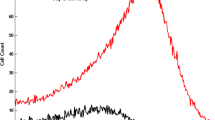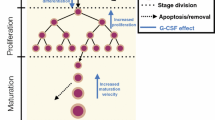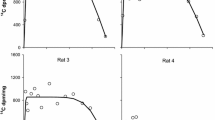Abstract
In the field of hematology, several mechanism-based pharmacokinetic-pharmacodynamic models have been developed to understand the dynamics of several blood cell populations under different clinical conditions while accounting for the essential underlying principles of pharmacology, physiology and pathology. In general, a population of blood cells is basically controlled by two processes: the cell production and cell loss. The assumption that each cell exits the population when its lifespan expires implies that the cell loss rate is equal to the cell production rate delayed by the lifespan and justifies the use of delayed differential equations for compartmental modeling. This review is focused on lifespan models based on delayed differential equations and presents the structure and properties of the basic lifespan indirect response (LIDR) models for drugs affecting cell production or cell lifespan distribution. The LIDR models for drugs affecting the precursor cell production or decreasing the precursor cell population are also presented and their properties are discussed. The interpretation of transit compartment models as LIDR models is reviewed as the basis for introducing a new LIDR for drugs affecting the cell lifespan distribution. Finally, the applications and limitations of the LIDR models are discussed.






Similar content being viewed by others
References
Perez-Ruixo JJ, de Ridder F, Kimko H, Samtani M, Cox E, Mohanty S, Vermeulen A (2008) Simulation in clinical drug development. In: Bertau M, Mosekilde E, Westerhoff HV (eds) Biosimulation in drug development. Wiley-VCH Verlag GmbH & Co KGaA, Weinheim, pp 3–24
Mager DE, Wyska E, Jusko WJ (2003) Diversity of mechanism-based pharmacodynamic models. Drug Metab Dispos 31:510–519
Mackey MC (1996) Mathematical models of hematopoietic cell replication and control. In: Othamer HG (ed) The art of mathematical modeling: case ctudies in ecology, physiology and biofluids. Prentice Hall, New York
Krzyzanski W, Ramakrishnan R, Jusko WJ (1999) Basic pharmacodynamic models for agents that alter production of natural cells. J Pharmacokinet Biopharm 27:467–489
Krzyzanski W, Perez-Ruixo JJ, Vermeulen A (2008) Basic pharmacodynamic models for agents that alter the lifespan distribution of natural cells. J Pharmacokin Pharmacodyn 35:349–377
Krzyzanski W, Jusko WJ (2002) Multiple-pool cell lifespan model of hematologic effects of anticancer agents. J Pharmacokin Pharmacodyn 29:311–337
Harker LA, Roskos LK, Marzec UM, Carter RA, Cherry JK, Sundell B, Cheung EL, Terry D, Sheridan W (2000) Effects of megakaryocyte growth and development factor on platelet production, platelet life span, and platelet function in healthy human volunteers. Blood 95:2514–2522
Roskos LK, Lum Lockbaum P, Schwab G, Yang B-B (2006) Pharmacokinetic/pharmacodynamic modeling of pegfilgrastim in healthy subjects. J Clin Pharmacol 46:747–757
Wang YM, Krzyzanski W, Doshi S, Xiao JJ, Pérez-Ruixo JJ AT, Chow AT (2010) Pharmacodynamics-mediated drug disposition (PDMDD) and precursor pool lifespan model for single dose of romiplostim in healthy subjects. AAPS J 12:729–740
Pérez-Ruixo JJ, Krzyzanski W, Bouman-Thio E, Miller B, Jang H, Bai SA, Zhou H, Yohrling J, Cohen A, Burggraaf J, Franson K, Davis HM (2009) Pharmacokinetics and pharmacodynamics of the erythropoietin Mimetibody construct CNTO 528 in healthy subjects. Clin Pharmacokinet 48:601–613
Foley C, Mackey MC (2009) Mathematical model for G-CSF administration after chemotherapy. J Theor Biol 257:27–44
Friberg LE, Karlsson MO (2003) Mechanistic models for myelosuppression. Invest New Drugs 21:183–194
Doshi S, Chow A, Pérez Ruixo JJ (2010) Exposure-response modeling of darbepoetin alfa in anemic patients with chronic kidney disease not receiving dialysis. J Clin Pharmacol 50(9 Suppl):75S–90S
Sun YN, DuBois DC, Almon RR, Jusko WJ (1998) Fourth-generation model for corticosteroid pharmacodynamics: a model for methylprednisolone effects on receptor/gene mediated glucocorticoid receptor down-regulation and tyrosine aminotransferase induction in rat liver. J Pharmacokinet Biopharm 26:289–317
Perlstein I, Stepansky D, Krzyzanski W, Hofman A (2002) A signal transduction pharmacodynamic model of the kinetics of parasympathomimetic activity of low-dose scopolamine and atropine in rats. J Pharm Sci 91:2500–2510
Mager DE, Jusko WJ (2001) Pharmacodynamic modeling of time-dependent transduction systems. Clin Pharmacol Ther 70:210–216
Loeffler M, Wichmann HE (1985) Structure of the model. In: Wichmann HE, Loeffler (eds) Mathematical modeling of cell proliferation: stem cell regulation in hemopoiesis, vol 1. CRC Press, Boca Raton
Loeffler M, Pantel K, Wulff H, Wichmann HE (1989) A mathematical model of erythropoiesis in mice and rats, Part 1: Structure of the model. Cell Tissue Kinet 22:13–30
Schmitz S, Franke H, Brusis J, Wichmann HE (1993) Quantification of the cell kinetic effects of G-CSF using a model of human granulopoiesis. Exp Hematol 21:755–760
Wichmann HE, Gerhardts MD, Spechtmeyer H, Gross R (1979) Mathematical model of thrombopoiesis in rats. Cell Tissue Kinet 12:551–567
Freise KJ, Widness JA, Schmidt RL, Veng-Pedersen P (2007) Pharmacodynamic analysis of time-variant cellular disposition: reticulocyte disposition changes in phlebotomized sheep. J Pharmacokinet Pharmacodyn 34:519–547
Freise FJ, Widness JA, Schmidt RL, Veng-Pedersen P (2008) Modeling time variant distributions of cellular lifespans: increase in circulating reticulocyte lifespans following double phlebotomies in sheep. J Pharmacokinet Pharmacodyn 35:285–324
Freise FJ, Schmidt RL, Widness JA, Veng-Pedersen P (2008) Pharmacodynamic modeling of the effect of changes in the environment on cellular lifespan and cellular response. J Pharmacokinet Pharmacodyn 35:527–552
Krzyzanski W, Woo S, Jusko WJ (2006) Pharmacodynamic models for agents that alter production of natural. J Pharmacokinet Pharmacodyn 33:125–165
Dayneka NL, Garg W, Jusko WJ (1993) Comparison of four basic models of indirect pharmacodynamic responses. J Pharmacokinet Biopharm 21:457–478
Krzyzanski W, Jusko WJ (1997) Mathematical formalism for the properties of four basic models of indirect pharmacodynamic responses. J Pharmacokinet Biopharm 25:107–123
Krzyzanski W, Jusko WJ (1998) Integrated functions of four basic models of indirect pharmacodynamic response. J Pharm Sci 87:67–72
Friberg LE, Henningsson A, Maas H, Nguyen L, Karlsson MO (2002) Model of chemotherapy-induced myelosuppression with parameter consistency across drugs. J Clin Oncol 20:4713–4721
Krzyzanski W, Wiczling P, Lowe P, Pigeolet E, Fink M, Berghout A, Balser S (2010) Population modeling of filgrastim PK-PD in healthy adults following intravenous and subcutaneous administrations. J Clin Pharmacol 50(9 Suppl):101S–112S
Perez-Ruixo JJ, Krzyzanski W, Hing J (2008) Pharmacodynamic analysis of recombinant human erythropoietin effect on reticulocyte production rate and age distribution in healthy subjects. Clin Pharmacokinet 47:399–415
Hamrén B, Björk E, Sunzel M, Karlsson M (2008) Models for plasma glucose, HbA1c, and hemoglobin interrelationships in patients with type 2 diabetes following tesaglitazar treatment. Clin Pharmacol Ther 84:228–235
Agoram B, Heatherington AC, Gastonguay MR (2006) Development and evaluation of a population pharmacokinetic-pharmacodynamic model of darbepoetin alfa in patients with nonmyeloid malignancies undergoing multicycle chemotherapy. AAPS J 8:E552–E563
Krzyzanski W (2011) Interpretation of transit compartments pharmacodynamic models as lifespan based indirect response models. J Pharmacokinet Pharmacodyn 38:179–204
Holford N (2005) Pharmacokinetic/pharmacodynamic models for red cell responses to hematopoietic stimulation with and without chemotherapy. American Society of Clinical Pharmacology and Therapeutics Annual Meeting, Orlando, FL, March 2–5
Budha NR, Kovar A, Meibohm B (2011) Comparative performance of cell lifespan and cell transit models for describing erythropoietic drug effects. AAPS J 13:650–661
Soto E, Staab A, Doege C, Freiwald M, Munzert G, Trocóniz IF (2011) Comparison of different semi-mechanistic models for chemotherapy-related neutropenia: application to BI 2536 a Plk-1 inhibitor. Cancer Chemother Pharmacol 68:1517–1527
Woo S, Krzyzanski W, Jusko WJ (2006) Pharmacokinetic and pharmacodynamic modeling of recombinant human erythropoietin after intravenous and subcutaneous administration in rats. J Pharmacol Exp Ther 319:1297-06
Ramakrishnan R, Cheung WK, Farrell F, Joffee L, Jusko WJ (2003) Pharmacokinetic and pharmacodynamic modeling of recombinant human erythropoietin after intravenous and subcutaneous dose administration in cynomolgus monkeys. J Pharmacol Exp Ther 306:324–331
Ramakrishnan R, Cheung WK, Wacholtz MC, Minton N, Jusko WJ (2004) Pharmacokinetic and pharmacodynamic modeling of recombinant human erythropoietin after single and multiple doses in healthy volunteers. J Clin Pharmacol 44:991–1002
Krzyzanski W, Jusko WJ, Wacholtz MC, Minton N, Cheung WK (2005) Pharmacokinetic and pharmacodynamic modeling of recombinant human erythropoietin after multiple subcutaneous doses in healthy subjects. Eur J Pharm Sci 26:295–306
Woo S, Krzyzanski W, Duliege AM, Stead RB, Jusko WJ (2008) Population pharmacokinetics and pharmacodynamics of peptidic erythropoiesis receptor agonist (ERA) in healthy volunteers. J Clin Pharmacol 48:43–52
Uehlinger DE, Gotch FA, Sheiner LB (1992) A pharmacodynamic model of erythropoietin therapy for uremic anemia. Clin Pharmacol Ther 51:76–89
Freise KJ, Widness JA, Veng-Pedersen P (2010) Erythropoietic response to endogenous erythropoietin in premature very low birth weight infants. J Pharmacol Exp Ther 332:229–237
Samtani MN, Perez-Ruixo JJ, Brown K, Cerneus D, Molloy C (2009) Pharmacokinetic and pharmacodynamic modeling of pegylated thrombopoietin mimetic peptide (PEG-TPOm) after single intravenous dose in healthy subjects. J Clin Pharmacol 49:336–350
Mager DE, Woo S, Jusko WJ (2009) Scaling pharmacodynamics from in vitro and preclinical animal studies to humans. Drug Metab Pharmacokinet 24:16–24
Krzyzanski W, Perez-Ruixo JJ (2007) An assessment of recombinant human erythropoietin effect on reticulocyte production rate and lifespan distribution in healthy subjects. Pharm Res 24:758–771
Woo S, Krzyzanski W, Jusko WJ (2008) Pharmacodynamic model for chemotherapy induced anemia in rats. Cancer Chemother Pharmacol 62:123–133
Fetterly GJ, Tamburlin JM, Straubinger RM (2001) Paclitaxel pharmacodynamics: application of a mechanism-based neutropenia model. Biopharm Drug Dispos 22:251–261
Bulitta JB, Zhao P, Arnold RD, Kessler DR, Daifuku R, Pratt J, Luciano G, Hanauske A-R, Gelderblom H, Awada A, Jusko WJ (2009) Multiple-pool cell lifespan models for neutropenia to assess the population pharmacodynamics of unbound paclitaxel from two formulations in cancer patients. Cancer Chemother Pharmacol 63:1035–1048
Hairer E, Norsett SP, Wanner G (1993) Solving ordinary differential equations I: nonstiff problems. Springer, Berlin
Krzyzanski W, Bauer RJ (2011) Solving delay differential equations in S-ADAPT by methods of steps. p. 20 Abstr 2144 [www.page-meeting.org/?abstract=2144]
Perez-Ruixo JJ, Kimko HC, Chow AT, Piotrovsky V, Krzyzanski W, Jusko WJ (2005) Population cell life span models for effects of drugs following indirect mechanisms of action. J Pharmacokinet Pharmacodyn 32:767–793
McKenzie SB (1996) Textbook of hematology. Williams & Wilkins, Baltimore
Miyasata M, Tanaka T (2010) Lymphocyte trafficking across high endothelial venules: Dogmas and enigmas. Nat Rev Immunol 4:360–370
Krzyzanski W, Dmochowski J, Matsushima N, Jusko WJ (2006) Assessment of dosing impact on intra-individual variability in estimation of parameters for basic indirect response models. J Pharmacokinet Pharmacodyn 33:635–655
Khinkis LA, Krzyzanski W, Jusko WJ, Greco WR (2009) D-optimal designs for parameter estimation for indirect pharmacodynamics response models. J Pharmacokinet Pharmacodyn 36:523–539
Acknowledgment
This work was supported in part by NIH grant GM57980.
Author information
Authors and Affiliations
Corresponding author
Rights and permissions
About this article
Cite this article
Krzyzanski, W., Perez Ruixo, J.J. Lifespan based indirect response models. J Pharmacokinet Pharmacodyn 39, 109–123 (2012). https://doi.org/10.1007/s10928-011-9236-y
Received:
Accepted:
Published:
Issue Date:
DOI: https://doi.org/10.1007/s10928-011-9236-y




